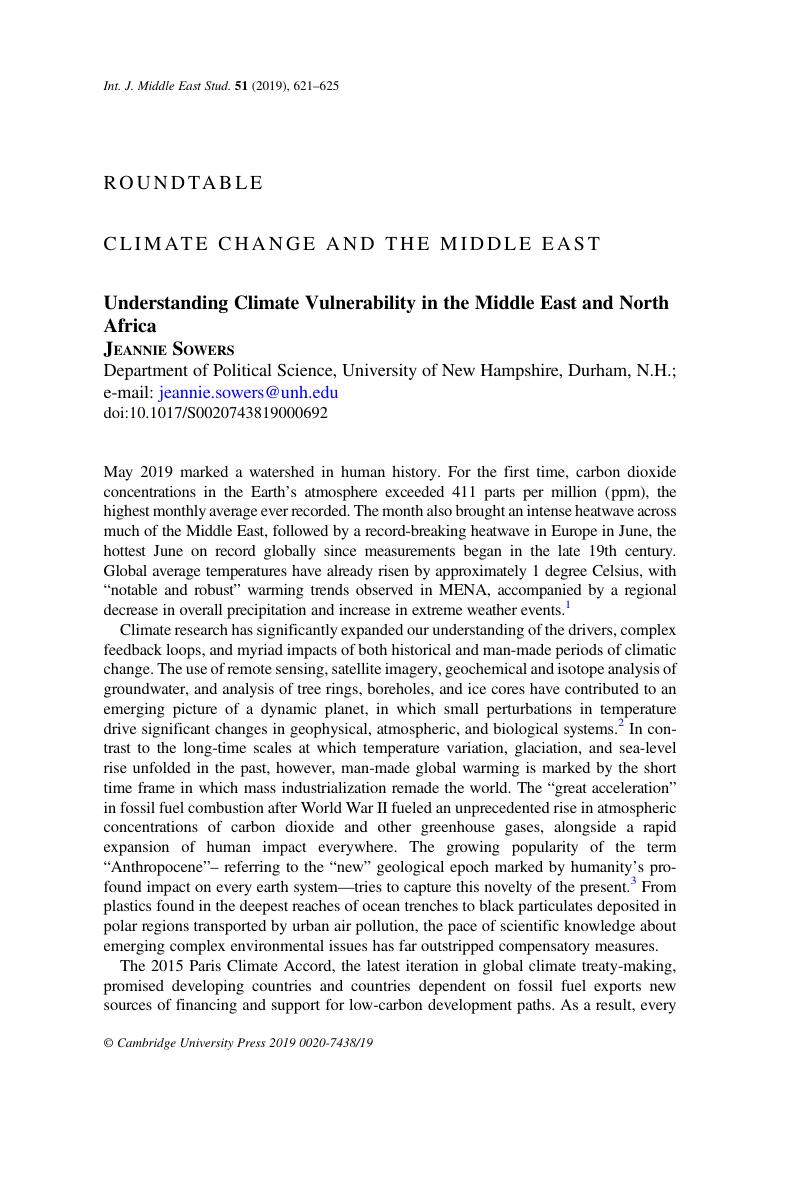May 2019 marked a watershed in human history. For the first time, carbon dioxide concentrations in the Earth's atmosphere exceeded 411 parts per million (ppm), the highest monthly average ever recorded. The month also brought an intense heatwave across much of the Middle East, followed by a record-breaking heatwave in Europe in June, the hottest June on record globally since measurements began in the late 19th century. Global average temperatures have already risen by approximately 1 degree Celsius, with “notable and robust” warming trends observed in MENA, accompanied by a regional decrease in overall precipitation and increase in extreme weather events.Footnote 1
Climate research has significantly expanded our understanding of the drivers, complex feedback loops, and myriad impacts of both historical and man-made periods of climatic change. The use of remote sensing, satellite imagery, geochemical and isotope analysis of groundwater, and analysis of tree rings, boreholes, and ice cores have contributed to an emerging picture of a dynamic planet, in which small perturbations in temperature drive significant changes in geophysical, atmospheric, and biological systems.Footnote 2 In contrast to the long-time scales at which temperature variation, glaciation, and sea-level rise unfolded in the past, however, man-made global warming is marked by the short time frame in which mass industrialization remade the world. The “great acceleration” in fossil fuel combustion after World War II fueled an unprecedented rise in atmospheric concentrations of carbon dioxide and other greenhouse gases, alongside a rapid expansion of human impact everywhere. The growing popularity of the term “Anthropocene”– referring to the “new” geological epoch marked by humanity's profound impact on every earth system—tries to capture this novelty of the present.Footnote 3 From plastics found in the deepest reaches of ocean trenches to black particulates deposited in polar regions transported by urban air pollution, the pace of scientific knowledge about emerging complex environmental issues has far outstripped compensatory measures.
The 2015 Paris Climate Accord, the latest iteration in global climate treaty-making, promised developing countries and countries dependent on fossil fuel exports new sources of financing and support for low-carbon development paths. As a result, every country in the MENA signed the agreement by 2016, except Syria in the midst of civil war. However, country ratifications, which require parliamentary approval and the adoption of a “voluntary national contribution” to reduce greenhouse gas emissions (GHG)emissions, have proceeded more slowly. As of June 2019, several MENA countries had yet to ratify the agreement or commit, including states riven by conflict (Libya, Yemen, Iraq, South Sudan), as well as Turkey, Iran, and Lebanon.
In reviewing the most recent national communications on climate change submitted to the UN by MENA countries under their Paris obligations, what stands out is the erasure of politics from considerations of climate risk and adaptation.Footnote 4 The national communications provide little insight into climate inequality or the political and economic factors that structure them. Many fundamental structural drivers of climate vulnerability are presented as exogenous conditions rather than as results of policy choices, cultural norms, and historical processes. These include such important transformations as rapid population growth, urbanization, rural-to-urban migration, and the status of women. None are treated as issues of political economy that help constitute how climate risk is distributed. For example, official population growth rates in Algeria and Egypt are twice those reported for Tunisia, but neither the Algerian nor the Egyptian authors discuss how family planning and social support could lessen vulnerability to climate risk at both the household and national levels. Gender is discussed only insofar as women are recipients and bearers of climate impacts, where “women,” particularly those in rural areas, are presumed to suffer more than men.
In light of the mass uprisings across much of the region in 2011–12, the erasure of politics in most of the national communications can take on surreal proportions. The events of 2011–12 and subsequent political contestations are entirely omitted in favor of oblique references to economic downturns, except in the cases of Tunisia and Yemen. Similarly, the various forms of social action centered on environment, health, land rights, and pollution issues around the region are entirely absent.Footnote 5 Only for Tunisia do the authors discuss how the revolution shaped climate governance. The revolution led to a 2014 constitution that includes climate security alongside rights to environmental protection, employment, and redress of regional imbalances. Furthermore, the report lauds postrevolution efforts to strengthen adaptation in the agricultural sector through “participative debates” between farmers, managers, and rural residents.Footnote 6 In contrast, Egypt's 224-page communication mentions “two revolutions” (e.g., the 2011 uprising and the 2013 military coup) once in the introduction, before presenting a technical compendium of anticipated projects across many sectors.Footnote 7 Saudi Arabia, which led the regional counter-revolution to the uprisings, abandons any pretense of discussing social vulnerability in its report. Instead, the authors reiterate the kingdom's long-standing position that “vulnerability” is expected to harm the Saudi hydrocarbon economy from any serious climate mitigation.
Neither advances in climate science nor exclusionary technocratic planning exercises provide adequate understandings of the social and political construction of climate vulnerability. Vulnerability to climate impacts is always as much a product of social, political, and economic factors as exposure to natural hazards. As Michael Mason, Mark Zeitoun, and Ziad Mimi argued in the context of the occupied Palestinian territories, “climate vulnerability is less about changes in physical systems than the political-economic contexts in which ‘climate risk’ is constructed and produced.”Footnote 8 Even where impacts are commonly shared, the distributive effects of the climate crisis are unequal both within and across countries. An environmental justice (or political ecology) lens—where class, ethnicity, race, geography, and communal affiliation are considered—can provide a more fine-grained understanding of the social construction of vulnerability. Understanding climate risk also benefits from a political economy perspective, which examines how strategies for maintaining (or retaking) power by states, regional players, and nonstate actors combine with patterns of economic development to structure vulnerability to climate change.
Let me propose two avenues of inquiry that take seriously analyzing man-made vulnerabilities to intensified climate variability. First, while some social scientists have argued that climate change is a driver of violent conflict, we should instead explore how war, occupation, and sometimes processes of reconstruction deepen social and ecological vulnerability to anthropogenic climate change. For example, whether drought contributed to the Syrian civil war has been the focus of a lively scholarly debate. Middle East scholars generally critiqued simplistic arguments about climate-driven conflict, highlighting the role of ill-considered agricultural policies and governmental neglect in creating vulnerability to drought, and the lack of correspondence between areas of drought, displacement, and revolt.Footnote 9 Yet the effects of civil and regional wars in destroying and degrading public services along with the social trust needed to cope with intensifying climate variability remain underanalyzed.
Some of the linkages between conflict and climate risk can be extrapolated from the case studies presented in Yemen's 2018 national communication under the Paris Accord. While the authors avoid political attribution for the conflict, they paint a bleak picture of how the conflict has lowered economic growth, increased poverty, increased malnutrition, and facilitated the spread of vector-borne diseases, including cholera and diptheria. Economic growth plummeted from a record high of 7.7 percent in 2010 to negative rates of -37.1 percent in 2015 and -34.4 percent in 2016 after the Saudi-Emirati campaign began in 2014.Footnote 10 The war led to rising prices, collapsing incomes, little market access, and the targeting of civilian infrastructure, particularly markets, agricultural land, and roads.Footnote 11 Poverty and food insecurity rose rapidly in rural areas, where families relied on local resources of fuel, fodder, and food, as well as urban areas that saw the most fighting. The absence of adequate markets and social support increased vulnerability to climate trends, such as changing rainfall regimes and hotter temperatures, that negatively affected crops, fodder, and water availability.
Second, the close connection between climate impacts on nature and increased social vulnerability also applies to many of the densely settled coastlines along the Red Sea, the Arabian Sea, and the Mediterranean Sea. Urbanization and economic activity have often centered on biodiverse landscapes of fisheries, shallow lagoons, and fertile coastal lands. These new areas are increasingly threatened by sea-level rise, land subsidence, and salinization, such as along the Mediterranean coasts of Egypt, Gaza, Israel, and Lebanon. The coastlines of Bahrain, Qatar, Kuwait, as well as parts of Oman, Yemen, and Saudi Arabia, feature colocated urban areas, industrial and energy facilities, tourism, and desalination plants, all increasingly vulnerable to intensified extreme weather events, including tropical storms and hurricanes originating in the Indian Ocean. Marine temperatures are already much higher than historical norms in much of the Red Sea and Arabian Seas, combined with more extreme hot days on land.Footnote 12 Adaptation for vulnerable coastal areas could consider integrating biodiversity and productive landscapes into coastal protection and the creation of more liveable cities. In much of the MENA, municipalities and governorates can foster efforts to restore mangrove groves, coral reefs, mudflats, sand dunes, and saltmarshes alongside prudent investment in “hard” infrastructures for coastal protection.
In this brief intervention, I have tried to show that understanding climate vulnerability first requires an adequate understanding of the political, economic, and social factors that structure climate risk. Yet as the above example of coastal areas suggests, vulnerability to climate impacts is not limited to humans. In the Anthropocene, sustaining ourselves may well require sustaining “nature” as well.


